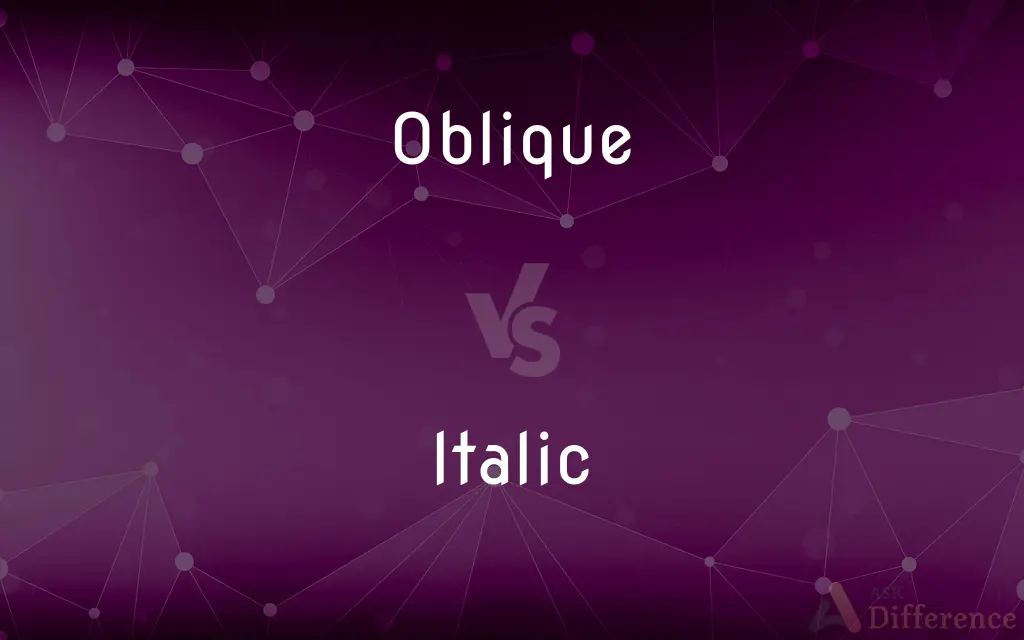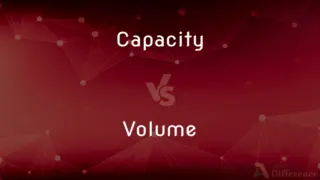Oblique vs. Italic — What's the Difference?
By Urooj Arif & Fiza Rafique — Updated on April 5, 2024
Oblique and italic refer to types of font styles where letters are slanted, but italic has a more stylized form with altered letter shapes, while oblique is simply a slanted version of the regular font.

Difference Between Oblique and Italic
Table of Contents
ADVERTISEMENT
Key Differences
Oblique typefaces are essentially the regular font style slanted at an angle, typically used to convey emphasis or distinction within text. They maintain the same character shapes as their upright counterparts, making them less distinct than italics. Whereas, italic typefaces not only tilt the letters but also often modify their shapes, giving them a unique appearance that can include variations in stroke width, the slope of letters, and the introduction of unique character forms, such as a single-story 'a' or a more curved 'f'. This stylization makes italic fonts particularly effective for emphasis and stylistic purposes.
In typography, the choice between oblique and italic is not merely aesthetic but functional. Oblique fonts, due to their straightforward slant, can be seen as a more subtle form of emphasis, often used in contexts where the text needs distinction without the stylistic flair of italics. On the other hand, italics, with their distinct alterations and historical roots in handwriting and calligraphy, offer a level of emphasis that is both noticeable and aesthetically pleasing, making them ideal for highlighting quotes, thoughts, or for use in creative writing.
The creation of oblique fonts is often a matter of digitally slanting the standard font, a process that can be automated within font design software. This method provides a practical way to create a differentiated typeface without designing each character from scratch. Italic fonts, however, require a more detailed and deliberate design process, where each character is individually crafted to ensure that the font maintains cohesiveness and visual appeal, reflecting the intricacies and artistry of traditional italic handwriting.
The use of oblique and italic typefaces extends beyond emphasis; they also play a role in readability and the visual hierarchy of text. Oblique fonts, by staying close to their original form, offer a subtle shift that can gently guide the reader's attention without disrupting the flow of reading. Italics, with their distinct character shapes and angles, create a more pronounced break in the text, drawing the reader's eye and signaling a change in tone, voice, or perspective.
Understanding when to use oblique versus italic fonts is crucial in typography and design. Oblique fonts are best suited for technical documents, digital interfaces, and situations where a modest deviation from the base font is necessary. Italics, with their stylistic richness and traditional significance, are preferred in literature, artistic works, and any context where a more pronounced form of emphasis or stylistic expression is desired.
ADVERTISEMENT
Comparison Chart
Definition
A slanted version of a regular font without altered letter shapes.
A font style with slanted and altered letter shapes, reflecting traditional handwriting forms.
Character Shapes
Maintains the same shapes as the regular typeface, only slanted.
Features unique letter forms and variations, often with a more pronounced slant.
Purpose
Provides a subtle emphasis or differentiation.
Offers a distinctive emphasis and stylistic flair, ideal for quotes and artistic text.
Design Process
Can be created by digitally slanting the standard font.
Requires individual crafting of each character for stylistic coherence.
Use Cases
Suitable for technical documents and interfaces where modest deviation is needed.
Preferred in literature, creative writing, and where stylistic expression is emphasized.
Compare with Definitions
Oblique
Digitally slanted from the regular font.
The web interface features text in oblique for its buttons.
Italic
A font style with slanted and uniquely shaped letters.
The author used italics to highlight thoughts in the novel.
Oblique
Offers a straightforward differentiation.
Email clients might use oblique text to indicate forwarded messages.
Italic
Ideal for quotes and creative texts.
Italicized words in the article indicated direct quotes.
Oblique
A font style where the letters are slanted but not altered in shape.
The designer used an oblique font for the subtitle to subtly catch the reader's eye.
Italic
Adds stylistic flair and emphasis.
Invitations often use italic fonts for aesthetic appeal.
Oblique
Intended for a modest emphasis within text.
Oblique text can differentiate a section without the flair of italics.
Italic
Requires individual design for each character.
The newly designed italic font featured a distinctive 'k'.
Oblique
Used in technical or digital contexts.
Technical manuals often use oblique fonts for annotations.
Italic
Derives from traditional handwriting and calligraphy.
The italic letters in the poem added a personal touch.
Oblique
Having a slanting or sloping direction, course, or position; inclined.
Italic
Relating to or denoting the branch of Indo-European languages that includes Latin, Oscan, Umbrian, and the Romance languages.
Oblique
(Mathematics) Designating geometric lines or planes that are neither parallel nor perpendicular.
Italic
The Italic group of languages.
Oblique
(Botany) Having the part on one side of the midrib of a different size or shape than the part on the other side. Used of a leaf.
Italic
Of or relating to ancient Italy or its peoples or cultures.
Oblique
(Anatomy) Situated in a slanting position; not transverse or longitudinal
Oblique muscles or ligaments.
Italic
Of or relating to the branch of the Indo-European language family that includes Latin, Faliscan, Oscan, Umbrian, and the Romance languages.
Oblique
Indirect or evasive
Oblique political maneuvers.
Italic
Italic Of or being a style of printing type patterned on a Renaissance script with the letters slanting to the right
This sentence is printed in italic type.
Oblique
Devious, misleading, or dishonest
Gave oblique answers to the questions.
Italic
The Italic branch of Indo-European.
Oblique
Not direct in descent; collateral.
Italic
Often italics Italic print or typeface.
Oblique
(Grammar) Designating any noun case except the nominative or the vocative.
Italic
Designed to resemble a handwriting style developed in Italy in the 16th century.
Oblique
An oblique thing, such as a line, direction, or muscle.
Italic
Having letters that slant or lean to the right; oblique.
The text was impossible to read: every other word was underlined or in a bold or italic font.
Oblique
At an angle of 45°.
Italic
(typography) A typeface in which the letters slant to the right.
Oblique
Not erect or perpendicular; not parallel to, or at right angles from, the base.
Italic
An oblique handwriting style, such as used by Italian calligraphers of the Renaissance.
Oblique
Not straightforward; obscure or confusing.
Italic
Relating to Italy or to its people.
Oblique
Disingenuous; underhand; morally corrupt.
Italic
Applied especially to a kind of type in which the letters do not stand upright, but slope toward the right; - so called because dedicated to the States of Italy by the inventor, Aldus Manutius, about the year 1500.
Oblique
Not direct in descent; not following the line of father and son; collateral.
Italic
A style of handwriting with the letters slanting to the right
Oblique
Having the base of the blade asymmetrical, with one side lower than the other.
Italic
A branch of the Indo-European languages of which Latin is the chief representative
Oblique
Growing at an angle that is neither vertical nor horizontal.
Italic
A typeface with letters slanting upward to the right
Oblique
(grammar) Pertaining to the oblique case (non-nominative).
Italic
Characterized by slanting characters;
Italic characters
Oblique
Indirect; employing the actual words of the speaker but as related by a third person, having the first person in pronoun and verb converted into the third person and adverbs of present time into the past, etc.
Italic
Of or relating to the Italic languages;
Ancient Italic dialects
Oblique
(music) Employing oblique motion, motion or progression in which one part (voice) stays on the same note while another ascends or descends.
Oblique
(geometry) An oblique line.
Oblique
Synonym of slash⟨/⟩.
Oblique
(grammar) The oblique case.
Oblique
(intransitive) To deviate from a perpendicular line; to become askew;
Oblique
(military) To march in a direction oblique to the line of the column or platoon; — formerly accomplished by oblique steps, now by direct steps, the men half-facing either to the right or left.
Oblique
To slant (text, etc.) at an angle.
Oblique
Not erect or perpendicular; neither parallel to, nor at right angles from, the base; slanting; inclined.
It has a direction oblique to that of the former motion.
Oblique
Not straightforward; indirect; obscure;
The love we bear our friends . . . Hath in it certain oblique ends.
This mode of oblique research, when a more direct one is denied, we find to be the only one in our power.
Then would be closed the restless, oblique eye.That looks for evil, like a treacherous spy.
Oblique
Not direct in descent; not following the line of father and son; collateral.
His natural affection in a direct line was strong, in an oblique but weak.
Oblique
An oblique line.
Oblique
To deviate from a perpendicular line; to move in an oblique direction.
Projecting his person towards it in a line which obliqued from the bottom of his spine.
Oblique
To march in a direction oblique to the line of the column or platoon; - formerly accomplished by oblique steps, now by direct steps, the men half-facing either to the right or left.
Oblique
Any grammatical case other than the nominative
Oblique
A diagonally arranged abdominal muscle on either side of the torso
Oblique
Slanting or inclined in direction or course or position--neither parallel nor perpendicular nor right-angular;
The oblique rays of the winter sun
Acute and obtuse angles are oblique angles
The axis of an oblique cone is not perpendicular to its base
The axes are perpendicular to each other
Oblique
Indirect in departing from the accepted or proper way; misleading;
Used devious means to achieve success
Gave oblique answers to direct questions
Oblique political maneuvers
Common Curiosities
What's the primary difference between oblique and italic fonts?
Oblique fonts are simply slanted, while italic fonts also alter the shapes of the letters for stylistic emphasis.
Can any font be made oblique?
Technically, yes, through digital slanting, but not all fonts may look aesthetically pleasing or remain readable when slanted.
Is there a preference for using italic fonts in certain genres of writing?
Yes, literature, creative writing, and academic works often prefer italics for emphasis, stylistic distinction, and to denote titles or special terms.
Why do italic fonts have different shapes?
Italic fonts mimic traditional cursive handwriting, which naturally alters letter shapes for fluidity and aesthetics.
Can oblique and italic fonts be used interchangeably?
While they can serve similar purposes for emphasis, their distinct appearances mean they are not always interchangeable, especially in formal or stylistic contexts.
Why are italic fonts often used for quotes?
Italics have a traditional association with emphasis and stylistic flair, making them ideal for distinguishing quotes within a text.
Are oblique fonts less common than italic fonts?
Not necessarily, but the choice between oblique and italic often depends on the document's context, style, and design requirements.
How do designers choose between oblique and italic?
Designers consider the document's purpose, the desired level of emphasis, and stylistic consistency when choosing between oblique and italic fonts.
How does the use of oblique or italic fonts impact readability?
Both can improve readability by providing emphasis and breaking up text, though italics, with their distinct shapes, may draw more attention.
Are there rules for using oblique and italic fonts in professional documents?
Professional documents typically follow specific style guides that may recommend one style over the other for consistency and clarity.
Share Your Discovery

Previous Comparison
Guilt vs. Conviction
Next Comparison
Capacity vs. VolumeAuthor Spotlight
Written by
Urooj ArifUrooj is a skilled content writer at Ask Difference, known for her exceptional ability to simplify complex topics into engaging and informative content. With a passion for research and a flair for clear, concise writing, she consistently delivers articles that resonate with our diverse audience.
Co-written by
Fiza RafiqueFiza Rafique is a skilled content writer at AskDifference.com, where she meticulously refines and enhances written pieces. Drawing from her vast editorial expertise, Fiza ensures clarity, accuracy, and precision in every article. Passionate about language, she continually seeks to elevate the quality of content for readers worldwide.
















































